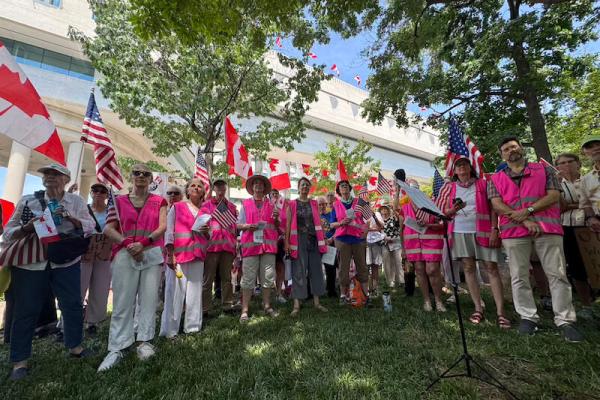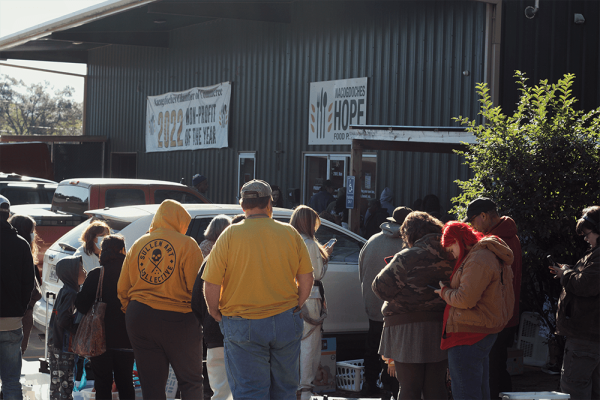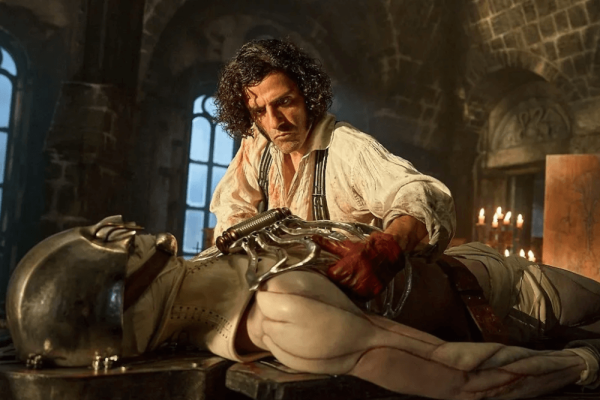This interview is part of The Reconstruct, a weekly newsletter from Sojourners. In a world where so much needs to change, Mitchell Atencio and Josiah R. Daniels interview people who have faith in a new future and are working toward repair. Subscribe here.
Despite what you may have heard about a “muted” response to President Donald Trump’s second term, the size and scope of protests in 2025 have far surpassed what we saw in 2017.
According to data compiled by Harvard political scientist Erica Chenoweth and researchers at the Crowd Counting Consortium, the vast majority of these protests have been nonviolent; in April and May — which included large nationwide protests like Hands Off!, No Kings, and May Day — 99.5% of the protests featured “no injuries, arrests or property damage.”
It’s front-page news when a protest goes badly — when public anger billows into hatred or violence, when police fail to keep everyone safe, or when public officials crack down on the right to peaceably assemble. But we rarely devote the same attention to the people who ensure a protest goes right. Show me a protest where folks left feeling buoyed to find themselves among so many others demanding change, and I’ll show you a constellation of different groups who worked behind the scenes to ensure participants felt welcome, safe, and free to express vulnerable emotions in public.
One of the groups working behind the scenes is the Rapid Response Choir. Formed earlier this year as executive orders and the Department of Government Efficiency ripped through the nation’s capital, this 100-member volunteer choir in Washington, D.C., arrives at local protests with matching neon pink vests and a repertoire of crowd-friendly protest songs. Their aim is less performative and more participatory; think church choir strengthening the voice of the congregation. Though the group holds practice in a church and seeded its membership from spreading the word to local congregational choirs, the group is intentionally not religious — they want people of all faiths or no faith to feel welcome to join in.
We tend to think about efforts like the Rapid Response Choir as a quirky sideshow or feel-good story, not a key ingredient for social change.
Overall, the Rapid Response Choir hopes their presence at protests “makes it feel [like] more of a community effort to make the world we want, instead of just a lot of pissed off people with signs,” said Jessica Arends, a local teacher and musician who serves as a volunteer coordinator for the Rapid Response Choir.
I talked with Arends and Peter Burkholder — a federal employee and member of a local Mennonite church who founded the group — about how the choir works, what they hope it brings to public demonstrations, and how anyone curious can start a choir of their own, no experience necessary.
This interview has been edited for length and clarity.
Betsy Shirley, Sojourners: I’d love to hear a little bit of your origin story. How did the choir get started?
Peter Burkholder: In January, we were facing the inauguration of the president of this administration, and it was also the 500th anniversary of Anabaptism. I had gotten pulled into a group of local volunteers that were getting trained up to be door guardians for a local Spanish-speaking church — getting trained to be white people in the foyer so if immigration agents were to show up, we’re the ones [who could say], “Sorry, we can’t let you in, this is a private service; can you show ID?”
But I was sitting there in the lobby thinking, “You know, if this [an ICE raid] happens, how would we get the word out, and potentially get media and maybe some elected officials showing up to witness what ICE was doing?” And I was sitting there, hearing the music in the church, thinking, “Wouldn’t it be amazing if they [the witnesses] were to show up singing? You know, what the world needs is a rapid response choir.”
A week later, I’m just sitting there furiously writing down what it would be like, and then at the practice for the College Park Chorale [a local choir], I said, “I’m going to start a rapid response choir. Who’s interested in joining me?” I gave a little more background, and 12 people were like, “Yes, let’s do that.” I put a page up on Google Docs and got out the word to a couple of other churches. We started having practices, moved [the practices] to Hyattsville Mennonite, got the website domain name, and then it was a month, I think March 4, when we had the opportunity through connection with the Chesapeake Climate Action Network to actually go forth and do our thing. Since then, we’ve been doing one to two events a week.
If I were at an event where the Rapid Response Choir was performing, could you paint me a picture of what I’d see or hear?
Jessica Arends: So, you will be able to spot us very easily. We have these very bright pink vests — which was Peter’s idea — and it has given us great visibility so we can find each other in the crowd. We like to start singing as we’re entering an event, walking in — just kind of bringing positivity into a rally or a protest. Often, we’ll have a guitar, maybe some drums or percussion. And then we sing our songs and try to interact with the crowd. We try to engage with folks as much as possible. Sometimes we do songs in Spanish, depending on the event. We also learned a French song for Canada Day, which was an accomplishment.
Rapid response choir 3, no photo credit.JPG
Burkholder: We’re there to bring music, to inspire, unify people, and hopefully bring some hope. The feedback we get just keeps us doing it more. People are like, “I am at so many protests where it’s just anger, and you bring lightness and joy and hope.” At the Kilmar Abrego Garcia events, we were outside the courthouse singing when the family came up, and we heard from the organizers how much that meant to them [the family] to hear people bringing music, joy, and solace to the event.
How do you interact with the crowd?
Arends: So, there’s sort of a spectrum: When you’re singing songs in this kind of environment, it can be more performative or it can be more participatory — and we really like to have people participate. It might be a call-and-response kind of thing or demonstrating that we want them to clap along. We also pass around our QR code so folks can scan and get our songbook that's on our website and see the lyrics there. Depending on the audience and the event, we have songs that are in different languages, so they’re more accessible for folks.
What makes for a good song to sing at protests? How do you choose what to sing?
Burkholder: I think there are a bunch of things that make for good songs. People being able to participate because either they can sing along, or they recognize the song. We’ve sung “Lean on Me” at some rallies, just because the song leader — whoever steps up and does it — has a lot of leeway in what songs they want to lead. I’m trying to have a bias to new songs that people are like, “Oh, this is one I haven’t heard before.” It’s not just recycling Pete Seeger.
When we are using older songs, I have a bias towards original lyrics. I mean, when you’re saying “which side are you on,” sometimes I just want to use the lyrics about Harlan County and West Virginia to remind people that this is not new.
[Activist Florence Reece wrote the song “Which Side Are You On?” in response to a 1931 miner’s strike; it’s been a popular song in labor movements and other protests ever since].
This is not the first time that people have faced injustice and used songs as part of the movement.
Parody songs have a place, but they tend to go stale pretty quickly; often, the lyrics just don’t have the same power because they’re just sort of written for laughs, but sometimes you need to strike a defiant tone. I try to find a balance between exuding hope and vision, but also admonishment and defiance. I try to avoid attack songs, because so much of the current political climate is just one side attacking another, and I don't think that's what I want to see our choir doing.
But mostly it is like karaoke. It’s not necessarily about performative beauty, but “Let’s just do this, let’s just sing and say what’s in our hearts and bring people along with you.”
Arends: I like to say what we lack in skill, we make up for with enthusiasm.
You are very intentionally drawing from a wide variety of sources and languages and styles of songs, but you also have an audience or a choir that’s not necessarily from the community or context that produced those songs. How do you approach that possible tension?
Arends: That has come up in the choir several times. We thought, “Gosh, we’re kind of diverse, but we’re also a mostly white choir and we’re singing songs from the gospel tradition of the Civil Rights Movement. Do we really have a right to sing some of these songs?” And my initial reaction was, “Well, we’ll just do some research and we’ll write a policy and we’ll post it on the website and if people have a question, they can go to the website.” And that’s kind of like the white person’s approach to this issue. I realized, OK, I need to be a little more open; there's value in the discussion and giving people space to really think through these questions.
I started talking with friends and networking with folks; we’ve also connected with a bunch of local choirs and people who have been thinking about this a lot longer than we have. So, I said, let’s have a panel discussion. We organized one with three panelists who were able to shed a lot of light on this and basically said: “With these songs, if you feel like there’s baggage around it, you need to talk about it.” There is a way to sing these songs respectfully, and that’s by, at a minimum, making sure the choir knows where these songs come from. And then, if possible, introducing the song by sharing the history, which is not always easy to do, because we’re not a performative space; we don’t have the audience sitting there quietly.
READ MORE: Christianity Should Radicalize You
Chester McCoy, a friend of mine who was on the panel and has a lot of experience with Civil Rights music said, “If people need to hear the song, then sing it.” These songs were meant to be sung. If the moment calls for it, then we can pay our respect to the creator by sharing the message of the song to help further the struggle.
Burkholder: And speaking of songs that need introductions, one song I always introduce now is “America the Beautiful.” I never thought I would be leading people in singing patriotic songs, but I got really tired of people adopting a very, very narrow idea of what patriotism meant. And then when you step back from “America the Beautiful” and look at some of the lyrics — particularly the UU version which took the original lyrics rearranged them a little bit, and dropped the verse about pilgrims wandering through the wilderness — it can recast what it means to be a patriot and a hero. So, I introduce it now saying, “People are trying to tell us who our heroes and patriots are. And we know that true heroes and true patriots are those who stood up for freedom from the self-emancipated, to the abolitionists, to the suffragettes, to the union workers in West Virginia facing down the thugs, to the AIDS activists in the ’80s, to transgender people today trying to lead their own best lives. These are the heroes and patriots that make America beautiful.” And then we jump in, and it works.
Though you both are members of local congregations, your choir is intentionally not religiously affiliated. What do you think religious groups have contributed directly or indirectly to your efforts?
Burkholder: Well, I appreciate the religious traditions that have developed choral backgrounds and four-part harmonies, because without that, I think there’d be just much less participation musically. I mean, we welcome anyone of any musical background, but when we just break into harmony singing “Finlandia,” it’s like, oh, we didn’t practice that. People just happen to know the tune from their religious traditions, and that’s beautiful.
Solid Anabaptist energy there. Love it.
Arends: Some of the lineage that we’re drawing from, the gospel music that informed the Civil Rights music, we’re very indebted to those singers in that lineage.
Some of the lineage that we’re drawing from, the gospel music that informed the Civil Rights music, we’re very indebted to those singers in that lineage.
-Jessica ArenDs
Burkholder: We have folks that come from different faiths that are part of the choir: people who are active Christians, people who grew up Jewish or are active in the Jewish tradition, and then people who are not affiliated but want to come and sing. I know a lot of people gain some solace just from coming to our rehearsals, because singing together is healing.
Arends: It’s a way of building community. We thought about scaling back to every-other-week for rehearsal, and I was really adamant that we have to meet every week, because we’re giving a space for people to come together, not online, but in person, and feel community, and literally, you know, sing the same note together, be in tune with one another. That’s been so meaningful for a lot of people.
What’s the message you hope the choir conveys?
Burkholder: I call to mind the images of the water cannons being used on protesters. I hope it doesn’t come to that, but it’s the contrast between the violence of the perpetrators versus the peacefulness of those standing in opposition. How does that [contrast] change the conversation and remind people that those opposing the targeting of communities are doing it out of a sense of hope and love and solidarity, and not just because they stand in opposition to a regime or a policy or an administration?
I also hope it gets people thinking: “What can I be doing that isn’t just part of the standard playbook?” I mean, I had never run a choir or even done much song leading outside of being a camp counselor until I decided this needed to be done. The times demand us to do things that may be uncomfortable at first, but it’s what we’re called to do, so let’s do it. It makes me feel so much comfort and joy to wake up and say, “Well, the news is awful, but at least we’re here, trying to do something about it.”
The times demand us to do things that may be uncomfortable at first, but it’s what we’re called to do, so let’s do it. It makes me feel so much comfort and joy to wake up and say, “Well, the news is awful, but at least we’re here, trying to do something about it.”
-Peter Burkholder
If someone wants to start a choir like this on their own, what advice would you give them?
Burkholder: If you’re already with a group of singers, stand up and ask, “Hey, do you want to do this?” It takes … not that many people. We’re working to provide a lot more resources for people to start their own choirs, but no one should wait on that. If you want to do it, just go off and do it, and email us if you want help.
Arends: After our first event, we had people contacting us from New York and California, and we got national coverage, so the interest was there across the country. You don’t need permission. You can certainly jump to it if you have a quorum, and yeah, lots of information on the website.
Burkholder: Also, [we’ve learned] song leading is a skill, and I have so much more appreciation for my choir directors.
Arends: I lead singing at my Quaker church, but it’s a very different environment when you're out in this very public event. So, practicing and offering some grace for people when they’re trying to up their skills, that’s definitely an important piece. But just try it, you know, don't feel like you have to have super honed expertise with these kinds of things.
Burkholder: Enthusiasm can go a long way. I would say karaoke is good training; when you learn in a bar that you just go in and sing with confidence, you’ll have people. And then you can bring that same energy standing up in front of a choir.
Arends: Being willing to be stretched outside of how you might have been trained or what’s comfortable for you is really critical. We have choir members who are like, “I sing in choirs, and I have a score in front of me.” It’s a very controlled environment, there’s performers and there’s an audience. And I’m really pushing to try to get people to be more comfortable with improv-ing or call and response, or, “Ok, the moment calls for this song, it wasn’t on our list to do, but we’re going to do it.” We bring our own cultural assumptions about how music should be. So being willing to shake some of that up, I think it’s also a really critical piece.
Editor's note: This article was updated on Aug. 5 to correct a misspelled name. It's Jessica Arends, not Ahrens.
Got something to say about what you're reading? We value your feedback!






